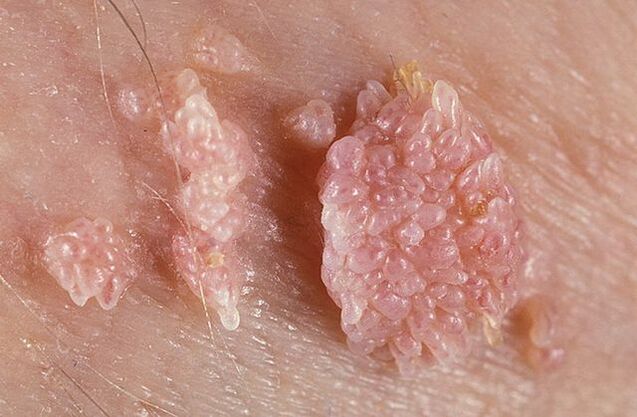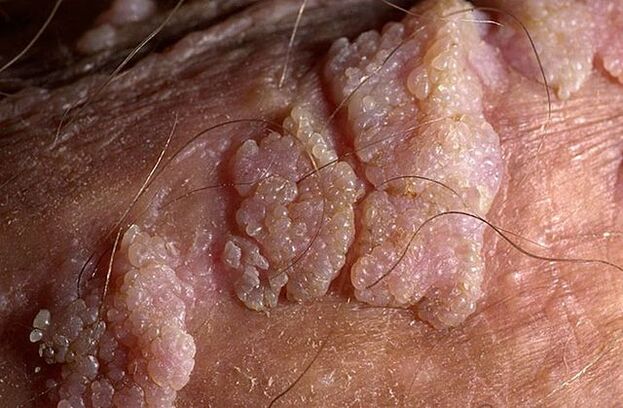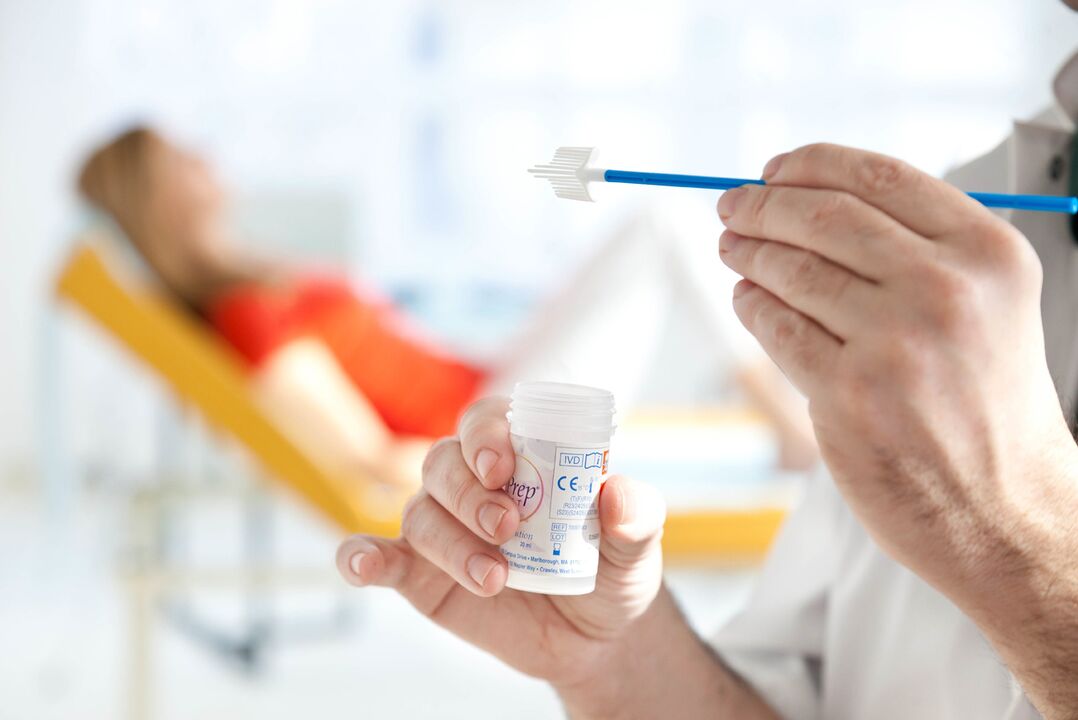The appearance of cone-shaped flesh-colored growths in the genital area raises concerns, which are completely justified, since the health of the genital organs is an important point of general physical and moral well-being of a person.
These growths of warts cause discomfort, interfere with a normal sexual life, and can also cause more serious health problems. If the integrity of the condylomas is violated, an infection may occur and turn into a malignant formation. Therefore, the desire to get rid of such manifestations is understandable and quite natural.
Reasons for appearance
The cause of papilloma warts is the human papillomavirus. This virus contains a certain set of DNA that successfully integrates into the cells of the human body and causes them to change their developmental cycle, shape and structure.

According to the International Classification of Diseases ICD-10, human papillomavirus is coded as B97. 7. Code A63 is assigned to anogenital warts of a venereal nature. 0.
There are many different strains of this virus, each of which causes specific warty papillomas. The type of virus determines the course of the pathological process, symptoms, place of manifestation and severity of complications.
Strains are divided into two main types:
- dermal, predominating in the skin layer;
- mucous membranes that appear on the mucous epithelium of the genitals, oral cavity, etc.
In addition, the types of papillomavirus differ depending on the risk of degeneration into an oncogenic process into oncogenic, moderately oncogenic and non-oncogenic.
Most often, the body of an infected person has several different strains at the same time.
Routes of infection and risk factors
The pathogen can enter the body in several ways:
- "Vertical" transmission. This is called the transmission of an infectious agent from mother to child during pregnancy. Currently, it is not known whether the infection occurs prenatally or directly during childbirth, but it is not advisable to perform a cesarean section on a mother with papillomavirus. A cesarean section is chosen only if the papillomas bleed inside the birth canal.
- Sexual way.An infectious agent can enter the body during vaginal, oral or anal sex. The pathogen is also transmitted through saliva during kissing. Using a condom during sexual intercourse does not guarantee protection against the virus, but it reduces the likelihood of its transmission.
- Household method.This mechanism of disease transmission is quite rare. Infection can occur through contact with the patient's personal belongings. Since the virus is present in saliva and urine, it is possible to get infected by using other people's utensils, shared towels, personal hygiene products, from the toilet rim or in the sauna.
The mode of infection is mainly determined by the person's age: for babies, it is possible to determine with great certainty that the mother is infected, and for older children - through contact and household. From the age of 17, most cases are sexually transmitted.
According to statistics, the human papilloma virus is present in the body of more than half of the sexually mature population, but most of the time it does not manifest itself in any way and is in the form of carrier.
The peak of the disease occurs at a young age from 17 to 25 years. This is due to maximum sexual activity and high sensitivity of the epithelium of the organs of the urogenital system.
Predisposing factors that increase the likelihood of the disease are:
- early sexual activity;
- frequent change of sexual partners;
- age up to 25 years;
- sexual contact with people who previously had the human papilloma virus or other sexually transmitted diseases;
- pregnancy;
- imbalance of intravaginal flora;
- any chronic disease;
- endometriosis;
- treatment with cytostatics or glucocorticosteroids;
- overweight;
- thyroid gland dysfunction and insulin production disorder;
- hypovitaminosis.
Frequent stress and non-compliance with the principles of personal hygiene greatly increase a person's probability that the infection will enter the active phase after entering the body.

After introduction, the virus spreads throughout the body through the blood, attaches to cells, penetrates their structure and integrates its DNA into the cell's DNA. Then the affected cells begin to actively grow and divide, which is why condylomas appear.
Ways of development
After entering the human body, the virus does not cause any symptoms for some time.
The course of the disease follows this algorithm:
- Hidden period. At this stage, the carrier is unaware of the infectious pathogen, as there are no clinical manifestations. However, at this stage, a person is already contagious and can infect their partner through sexual intercourse. This latent period can last from 2-3 months to several years.
- The disease begins when the virus multiplies sufficiently in the body or when the protective mechanisms of the immune system are reduced. During this period, the first symptoms appear.
- Active development with increasing symptoms.
The further course of events develops in one of the following directions:
- self-healing with the complete disappearance of papilloma warts (usually observed at the end of pregnancy);
- slow progress and lack of skin growth;
- active dynamics of papillomas with an increase in shape, size, number and fusion of nearby groups;
- degeneration of benign growths into malignant ones.
Types of warts
There are several traditional types of condyloma papillomas:
- exophytic- protruding above the surface of the skin or mucous membrane, preferring outward growth;
- endophytic- predominant growth deep into the skin structures, so it is hardly noticeable during visual inspection;
- Buschke-Levenshtein education- characterized by a fast growth rate, large sizes and frequent relapses after a course of treatment. With this form, both external growth and damage to deep internal tissue layers occur.

Genital warts can have a thin or wide base. If the stem is thin, the tip may be sharp or spike-like. Papillomas with a broad base are quite rare. The color of all such growths is close to the color of the skin: from pulp to pink. The surface can be soft or covered with a layer of keratin.
Warts can appear singly or in groups resembling nodules. Sometimes such multiple groups reach sizes of 1. 5 cm. . When several groups merge, formations resembling cauliflower florets or rooster combs are formed. These growths make it easy to identify the disease after examination.
Single growths usually do not cause as much discomfort as large elements. In rare cases, they break and bleed a little.
Large formations are more problematic: they can become soaked, bleed, worsen due to a secondary infection that takes root in the affected areas.
Symptoms
The first symptoms appear after the end of the latent period, which in the shortest case lasts several weeks.
Condylomas appear as follows:
- a slight redness appears on the skin, which begins to itch;
- a rash appears on the skin or mucous membrane in the form of vesicles or small bumps;
- tubers gradually increase to 1-1. 5 centimeters in length;
- New rashes appear nearby, which also turn into condyloma papules.
Localization depends on the specific strain and the place of entry of the pathogen into the body:
- external genitalia;
- anus region (anogenital papillomas);
- inside the urethra;
- on the cervix;
- on the epithelium in the mouth (on the buccal surfaces, inside the tongue and lips).

The clinical picture in each specific case may vary depending on the individual's health status. In the case of small warts, no other symptoms are observed.
With a more severe course, the following accompanying symptoms are observed:
- itching or burning at the site of the rash;
- sensation of a foreign body in the perineum;
- moisture in the area of neoplasms;
- unpleasant smell from the place where there are condylomas.
In the case of physical activity, long walking or running, all the mentioned symptoms intensify.
In severe cases, fatigue, weakness, signs of intoxication, prolonged headache, fever and high temperature are observed.
Symptoms differ between men and women. This is due to anatomical differences and the peculiarities of sexual behavior.
Manifestations for men
Men's condylomas usually affect the scrotum, groin, pubis and various structural parts of the penis: head, body, frenulum and foreskin, groove of the coronary arteries. Localized near the urethra, papillomas acquire a bright red color, and this place often causes branching or a stream when urinating.

If the rash is near the anus, severe pain may occur during defecation, and there may be blood in the stool. Because of this, there is often a reflex fear of defecation, which leads to periodic constipation and sometimes hemorrhoids.
There is often a dull pain in the lower abdomen, a burning sensation and pain during sex, as well as when urinating.
Prolonged infection weakens a man's immunity, making him more vulnerable to respiratory diseases, which are more difficult to treat than usual.
Manifestations for women
The most common places for the appearance of papillomas in women are the perianal areas, where humidity and temperature constantly increase: the epithelium of the clitoris, the labia, the vaginal opening and the opening of the urethra. If the infection occurs during anal sex, a ring of growths may form around the anus.
Large growths often become secondarily infected, resulting in a strong odor, bleeding, ulcers, and severe pain when touched. There is irritation and severe discomfort when walking.
In 50% of women, whitish elements are formed on the cervix, which are detected during a routine colposcopy, before which they are treated with an acidic disinfectant that can enhance the white color of condylomas.
In some cases, all growths are on the mucous membrane of a woman's internal genitals, so she does not notice them until the scheduled visit to the gynecologist. This is often the reason why treatment is started later than men.
Often, women are embarrassed by formations in intimate places, which makes them refuse sex.
Rarely, papillomas appear in the mouth, and in extremely rare cases, on the pubis, thighs, neck or face.
Features of condylomatosis during pregnancy
If condylomatosis has been treated, pregnancy should be planned no earlier than a few months later. The period of abstinence from pregnancy is extended if the woman used antiviral drugs during the treatment. After successful treatment and maintained interval, you can become pregnant safely.
If the disease is detected already during pregnancy, it is recommended to wait for treatment until all the baby's organs are formed. Treatment after 28 weeks does not cause fetal development disorders.
The reasons why condyloma warts appear in pregnant women are a standard decrease in immunity, increased stress on the body and large fluctuations in hormones.

If the papillomas are located on the external parts of the genitals or in the perianal area and do not cause discomfort, the issue of treatment can be postponed until the birth of the child. However, in case of rapid growth, increase in size and severe pain, consult a doctor immediately. Sometimes, with a high rate of progression of the formations, their relaxation is observed, which can lead to rupture of the vagina.
This disease, as a rule, does not affect the formation of the fetus, but its effects include the condition of the mother and the birth process. If there are other infections, there is often a risk of premature birth.
When condylomas are damaged during the passage of the fetus through the birth canal, this often leads to infection of the baby and the development of laryngeal condylomatosis in the neonatal or thoracic period. Therefore, the presence of significant papillomas in the birth canal is a direct indication of cesarean section.
If necessary, the tumor is removed during pregnancy, after which the tissue is sent for histological examination to verify its benign nature.
The use of traditional medicine methods to get rid of condylomas during pregnancy is unacceptable, as it may not only not have a positive result, but also cause the degeneration of benign cells into malignant ones.
Formations that do not cause discomfort during pregnancy often disappear on their own without treatment within a few months after childbirth, as the woman's hormonal balance normalizes.
Diagnostics
If the patient notices symptoms reminiscent of the human papilloma virus, he should consult a gynecologist, urologist or venereologist.
First of all, the specialist conducts a survey to find out the following:
- the time when the patient detects the first symptoms;
- possible causes of infection;
- the dynamics and development of the disease until the visit to the doctor.
After that, a clinical examination is performed, during which the specialist determines the location, intensity, size and condition of the growths. Women undergo an additional colposcopy (examination of individual genitals under magnification) or an extended colposcopy (a similar procedure using an acetic acid solution).
For a more accurate diagnosis, the doctor prescribes the following additional tests:
- PCR diagnostics, allows detection of the pathogen in fragments of the epithelium of damaged areas and determination of its amount (also allows identification of the virus strain);
- anoscopy- visual examination of the area near the anus with magnification;
- cytology and histologyfragments of formations to identify atypical cells or tissues;
- biopsy of growthsfrom epithelial tissues for microscopic examination of tissue structure;
- antibody titer detectionfor this virus;
- smearfrom the cervical canal and cervix for microscopic oncocytology.

Dermatologist or proctologist consultations are provided if necessary. If the diagnosis is performed on a pregnant woman, it is necessary to consult an obstetrician-gynecologist.
After receiving all the necessary data, the specialist can choose individual treatment tactics and completely get rid of the disease.
Treatment
Often with condylomatosis, people avoid visiting medical institutions and choose therapy themselves, preferring local drugs that can eliminate visible manifestations, but do not cure the infection in the body, moving it to a latent stage. Such treatment almost always leads to relapse. Therefore, the final cure requires an integrated approach that can only be determined by a specialist.
Treatment is carried out in the following areas:
- removal of growths;
- fight the virus;
- strengthen the patient's immunity.
All methods used in the fight against genital warts are divided into radical and medical.
Radical methods
Such methods are chosen if there is an urgent need to remove external manifestations or when condylomas are localized on the cervix in women.
The following methods are used for removal:
- Surgical excisionformations using a scalpel under local or general anesthesia. The incision site is sutured with a surgical suture. Despite the fact that this method is considered classic, it often causes postoperative bleeding and long-term rehabilitation in the hospital, so recently surgical removal is used less and less.
- Cryodestruction with liquid nitrogen.This method is relatively inexpensive and safe, and does not require anesthesia or anesthesia. After freezing, the proteins of the formations are destroyed, the nodules dry up and fall off. After a few weeks, there are no scars or scars at the treatment site.
- Laser removal.Despite its safety and high efficiency, the method requires anesthesia and is characterized by a high cost, so it is prescribed if other methods cannot be used. Under the action of the laser beam, the structure of the growth stem is destroyed. After cauterization, the condyloma is deprived of nutrition, which in a few days causes its necrosis and the scab disappears. Scars often remain after laser removal.
- Electrocoagulation.The method is affordable, but very painful, so it requires local anesthesia. Genital growths are exposed to high temperature, during which the papillomas are cauterized. Scabs fall off on their own after a few days, leaving scars.
- Radiosurgery.Currently, this is the most advanced, fast and effective method, which leads to its high price. Using high-frequency radio waves, genital warts are painlessly removed in 15-30 minutes. After such removal, there is no bleeding, healing occurs within a day, after which no marks remain on the skin.
- Destruction by chemicals.This technique is only suitable for small formations without road fusion. Special strong substances are used, which cause the death of growth cells. These products are based on highly concentrated acids or alkalis that cause local chemical burns.
If we limit ourselves to only radical methods of combating condylosis, condylomas recur in every third case.
Drug therapy
An integrated approach includes the removal of benign formations, elimination of the virus from the body and improvement of the immune status. Therefore, drug treatment includes the use of such drugs:
- Pharmacy productsagainst wart necrosis, acceptable for home use. This product should be applied to the warts for several days. If the drug gets on healthy tissues near the growth, a deep chemical burn will occur, so the drug should be applied very carefully. Take a short break of a few days after daily use. If the shoot does not fall, the course is repeated. Pharmaceutical products that cause growth necrosis are solutions and ointments.
- Antivirus agents.They can be for local or systemic use.
- Immunomodulatorsto improve immunity.
In addition, in order to improve the body's defenses, multivitamin complexes, a special diet and a healthy lifestyle are used systematically.
Immunity to condylomatosis does not develop after treatment, so re-infection from a former sexual partner is possible.
Possible complications
Long untreated condylosis causes the following complications:
- Attachment of bacterial infection to damaged condyloma papillomas, causing purulent formations, balanoposthitis and ulceration in the perianal area.
- When growths grow in the urethra, viral-bacterial urethritis can develop, which can lead to difficulty urinating, urinary retention, and urinary tract infection.
- When large formations are localized in the anus, bleeding from hemorrhoids and paraproctitis appear.
- Genital warts can affect a person's sex life, so he refuses to have sex. All this often leads to depression and psychological problems.
- Women may develop cervical erosion and dysplasia.
- The greatest danger is the risk of benign tumors degenerating into cancer (penile head or cervical cancer).
Preventive measures
Prevention of condylomatosis is divided into specific and general.
Specific preventive measures include vaccination with the new quadrivalent vaccine. These vaccines do not affect all strains of the human papillomavirus, but they successfully fight the most dangerous of them, which cause cervical cancer. Vaccination is carried out from the age of 11 and is repeated three times.
Non-specific prevention is similar to measures common to many sexually transmitted diseases:
- use of barrier contraceptives;
- personal hygiene at an appropriate level;
- permanent sexual partner;
- regular examination by a gynecologist or andrologist;
- timely treatment of diseases of the pelvic organs;
- quit alcohol and smoking.
In addition, it is necessary to avoid stress, physical fatigue, hypothermia and any factors that weaken the immune system. A healthy diet, better health and adequate sleep will help prevent genital warts.
















































































